BETWEEN PRACTICE AND THEORY
By Futoshi Hoshino
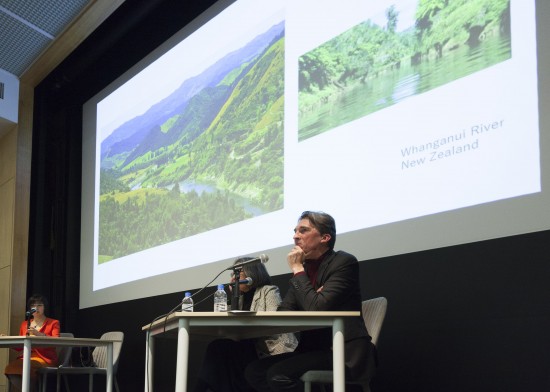 Nicolas Bourriaud lectures at Tokyo University of the Arts, January 8, 2018. Photo: Shu Nakagawa, courtesy Tokyo University of the Arts.
Nicolas Bourriaud lectures at Tokyo University of the Arts, January 8, 2018. Photo: Shu Nakagawa, courtesy Tokyo University of the Arts.One of the premier intellects in the fields of contemporary art and philosophy, Nicolas Bourriaud is best known as the critic who originated the idea of relational aesthetics – the term he coined in the catalogue of the exhibition he curated in 1996 at CAPC musée d’art contemporain de Bourdeaux, “Traffic,” and which was further popularized in the collection of essays published in English by Les Presses du réal in 2002, Relational Aesthetics. Inspired by the work of artists such as Dominque Gonzalez-Foerster, Liam Gillick and Rirkrit Tiravanija, Bourriaud’s vision of an art that uses social relations as its medium and context has had an indelible influence on the artistic practice of the past two decades – especially in Asia, where strategies of relational aesthetics were readily taken up and adapted in emerging art scenes that had little institutional or market infrastructure to begin with, and have also been integral to the formulation of community-centered art festivals in Japan. But Bourriaud is no mere exponent of a single idea. He was also the founding director, with Jérôme Sans, of a center for experimental projects in Paris, Palais de Tokyo, and has organized exhibitions including the Tate Triennial 2009, “Altermodern,” and the Taipei Biennial 2014, “The Great Acceleration.” Recent books include The Radicant (2009) and The Exform (2016). After overseeing the École nationale supérieure des Beaux-Arts in Paris from 2011 to 2015, Bourriaud is now the director of a new initiative in Montepellier, La Panacée-MoCo (Montpellier Contemporain), which will combine an art center and educational institution, and where he has presented his most recent exhibition, “Crash Test: The Molecular Turn,” which surveys the art of the past decade.
On the invitation of the Graduate School of Global Arts at Tokyo University of the Arts, Bourriaud visited Tokyo in January 2018 to give a series of special lectures on the theme of “Art and Culture in the Age of Globalization.” These included a lecture open to the general public, “The Relational Landscape of the 21st Century: Art Between Human and Non-Human Spheres,” at which he introduced his current thinking on the role of art in a world where conceptual divisions between nature and culture, subject and object are disintegrating, and all people are “livestock” for the farming of personal data. On behalf of ART iT, Futoshi Hoshino, lecturer in the Faculty of Fine Arts at Kanazawa College of Art, and translator into Japanese of texts including Claire Bishop’s “Antagonism and Relational Aesthetics” and Quentin Meillassoux’s After Finitude, met with Bourriaud during his stay to ask about his early career and intellectual development.
“Crash Test: The Molecular Turn” opened at La Panacée-MoCo on February 10 and continues through May 8.
Interview:
ART iT: I’d like to begin from the beginning of your career, about which there is a surprising lack of information available in English. I read that Yves Klein, Pierre Restany and Nouveau Réalisme were important for your early development. In what way did they influence you?
NB: I first encountered them when I was 17 years old. At the time I already knew it would be difficult for me to choose between literature and art, action and reflection, words and images. I didn’t know so much about modern and contemporary art, but one day I visited the Yves Klein retrospective that was held at the Centre Pompidou in 1983. I was fascinated by the exhibition, and then in the catalogue I read about this incredible character, Pierre Restany, who was doing exactly what I wanted to do: he was a curator, art critic and theoretician. Once I discovered him and the influence he had on Nouveau Réalisme in the 1960s, I knew what to do: not to choose. I would be like a seahorse, always floating between words and images, or like someone who serves as a mediator between two sides. At the time, in the early 1980s, there were not many figures who could provide such a model – just Restany and Harald Szeemann. The independent, freelance curator was not so common then.
ART iT: In 1985 you founded the Société perpendiculaire with some peers in Niort, and then in 1995 you established the Revue perpendiculaire after having founded Documents sur l’art in 1992. It strikes me as an enigmatic period in your career. Could you tell me more about it?
NB: Yes, Société perpendiculaire started out as a group of friends, but some of the others became quite important writers, such as Jean-Yves Jouannais, who wrote an incredible book about garden dwarfs and idiocy, Des nains, des jardins: Essai sur le kitsch pavillonnaire (Dwarfs, gardens: An essay on suburban kitsch), for example. We gathered around the idea of the perpendicular, which was not only literary but crossed disciplines and mediums. The “perpendicular” comes from a very simple image. Although it no longer holds true, at the time and for centuries prior cultural life had been organized in terms of parallel lines corresponding to different cultural strata: official culture, underground culture, popular culture, and all their subdivisions. So the perpendicular was the line that crossed them all, making connections between pop culture and the avant-garde and so on. This image was what brought us together. And although it was an informal group of friends, we came up with a completely absurd bureaucratic structure for organizing our activities, with departments and sub-departments. Then 10 years later the idea took new form with the creation of the literary journal that we founded with Michel Houellebecq, Revue perpendiculaire. That was when our group became more oriented toward literature, but still with the intent of bringing the energy of contemporary art into the field of literature, and also exploring how to bring the worlds of enterprise and electronic music into literature.
ART iT: Revue perpendiculaire ended in controversy over Houellebecq’s novel The Elementary Particles, which was published in French in 1998. Could you explain more about the political stance of the group?
NB: We were divided over Houellebecq’s book. There were many things that we found to be ambiguous in it, in terms of the racist tendencies and overly simplistic view of the world that it expressed. So we wanted to know if it was simply the characters in the novel who had these ideas, or Michel himself. It appeared that they were in fact Michel’s ideas. He was taking a very political stance, becoming a guru of a sort. In the end we decided to expel him from the group, because we couldn’t work with him knowing that we didn’t share the same values. It caused a big scandal in all the newspapers and weekly magazines in France. Michel was being considered for the Goncourt Prize that year, and it was because of us that he had to wait another decade to win it. It was a huge blow for our publisher, so we were made to be the bad boys and got kicked out of the company. We said “Fuck you!” and off we went.
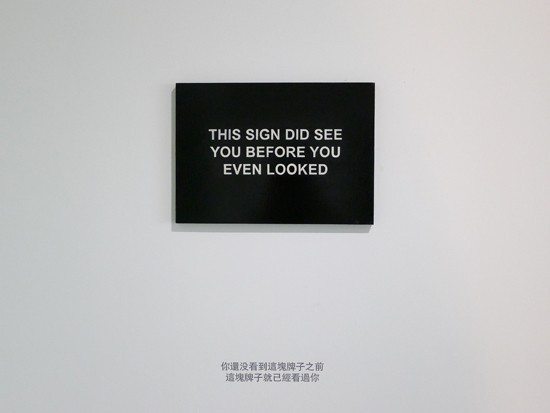 Laure Provost – Installation view, “The Great Acceleration,” Taipei Biennial 2014. Photo: ART iT.
Laure Provost – Installation view, “The Great Acceleration,” Taipei Biennial 2014. Photo: ART iT.ART iT: I’m curious about your own political attitude, and especially your relationship to Marxism. You mention Louis Althusser repeatedly in your books. It’s interesting to see how you connect his idea of the “materialism of the encounter” with art, but does your referencing of Althusser have any connection to political Marxism?
NB: I find Althusser’s “The Underground Current of the Materialism of the Encounter” to be a fascinating text, but I’m not that interested in the political Althusser. The texts he published while he was living are not as interesting as what appeared after his death. There was an image of Althusser when he was alive that is totally different from what emerged after he died. The text you mention is posthumous, and most of the important texts were posthumous. So mine is not a political interest. In general, I take Marx as a toolbox that I connect to other sources of energy. I never take it raw or pure.
ART iT: In Relational Aesthetics you mention other thinkers, including Michel Foucault, Guy Debord, and Deleuze and Guattari, who belong to the generation of 1968, while you were born in 1965. Was it usual for people in your generation to have an interest in these thinkers?
NB: Yes, even at school in the 1980s we were still very much influenced by the structuralist and poststructuralist thinkers. We learned the world through them. For me it was like a fish taking to water. They gave me my mother tongue in a sense.
ART iT: Regarding your curatorial work, it seems that the first exhibition you worked on as a curator was “Aperto” at the Venice Biennale in 1993. Had you organized any other exhibitions before then?
NB: The first exhibition I curated was the French Pavilion at Venice in 1990. The actual pavilion was being rebuilt, so they put me in charge of an exhibition of young artists in the prisons next to the Palazzo Ducale. The exhibition was called “Unmoving Short Movies,” and it included Philippe Parreno, Dominique Gonzalez-Foerster, Pierre Joseph, Fabrice Hyber and others. It was the first participation in Venice for all of us. We were all 25 years old. Can you imagine that? To have a show of 25-year-old artists in the official French Pavilion? It would never happen now. So I was really lucky to have that opportunity.
The next biennale was held in 1993, three years later instead of two, in order to realign the cycle with the exhibition’s centenary. That year Helena Kontova was in charge of “Aperto ’93,” and she asked me to curate a section. That’s where I started my friendships with most of the artists of my generation. Everyone was there, even those I didn’t invite myself – like Damien Hirst! It was really funny.
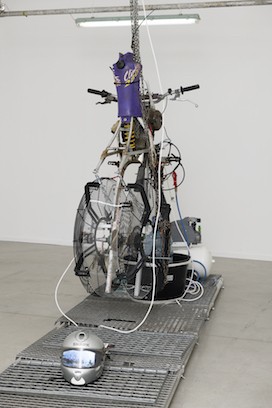
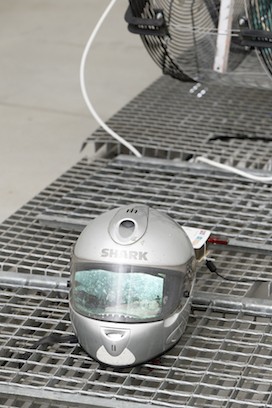
Thomas Teurlai – Night Shot-Holly Fumes (2017-2018), installation view in “Crash Test: The Molecular Turn” at La Panacée-MoCo, Montpellier, 2018. Photo: © Aurélien Mole, courtesy Thomas Teurlai.
ART iT: I find it amazing that while curating landmark exhibitions from “Traffic” (1996) to “Altermodern” (2009), and overseeing institutions such as Palais de Tokyo in Paris, you continued writing theoretical works. There are only a few star curators in the world, and most of them focus on curation, whereas you keep writing and publishing. What is your motivation for doing that?
NB: It relates to your first question. My idea was always to invent a position where I wouldn’t have to choose between action and reflection but could combine both in a kind of spiral movement so that every exhibition would lead me to transform my theories, and every theory would lead me to produce a new exhibition. I always say that when I have a question, I curate an exhibition, and when I have a few answers, I write a book. There has to be a dynamic relationship between writing and curating, because they do not share the same grammar. The exhibition is for me the place for interrogating or sometimes verifying ideas, but at the same time every exhibition always exceeds or goes somewhere other than what I anticipate at the start, and then that feeds into the next step.
Another thing I say is that I’m not a philosopher, I’m a curator who writes. Maybe that’s why I like figures such as Walter Benjamin, who called himself a private thinker, or Jacques Lacan, who was a psychoanalyst who wrote, or Georges Bataille. They were outsiders, and I also want to remain an outsider in the field of thought in some way. My writing is fed by the groundwork of my exhibition making, and I use art as an optical tool to see the world.
ART iT: You have made contributions to the fields of literature and music in addition to art and theory. We already discussed Houellebecq, but your own novel, L’Ere tertiaire, was published in 1997. It was a kind of science fiction, right?
NB: It’s a very weird story. The book is a rewriting of the myth of Noah’s ark, only Noah has been replaced by a corporation that is in charge of saving whatever can be saved from the world before the coming of the flood. There are many lists of things to be saved, which are then replaced the next day by new lists, and so on. I wanted to have some constraints – similar to Georges Perec – so the book has 64 chapters, and each chapter corresponds to a figure in the I Ching. But nobody knows that, because I’ve never said it before, and it’s not written anywhere.
ART iT: Have you thought about writing a second novel?
NB: I’ve been writing for years, actually, but I like the idea of writing something that would be the perfect posthumous book.
ART iT: Regarding music, you curated the exhibition “Playlist” at Palais de Tokyo in 2004, and allusions to musical figures such as the DJ recur throughout your book Postproduction. How do you view music as a genre?
NB: I was engaged in music from the start. Strangely enough, a record label dug up the recordings I did with my friends in the 1980s and released them on vinyl recently. There was a full page in Libération about it, even though only 1000 copies were pressed. It was quite hard-edged music. We were influenced by the industrial music of the 1970s, like Throbbing Gristle and Cabaret Voltaire, which we mixed with extra-European references such as Indian tablas. Music has always been in my life, and even now I still deejay from time to time.
ART iT: The influential Japanese art critic Noi Sawaragi, who belongs to more or less the same generation as you, also has a background in music. His first book, Simulationism: House Music and Appropriation Art (1991), was the first theoretical book on simulationism published in Japan, and also drew connections between musical techniques such as sampling and remixing and new developments in visual art.
NB: The last big event in music was the birth of electro and techno music at the end of the 1980s. That was basically the last time something completely new appeared that had nothing to do with what had come before. Since then, there has been a lot of reworking of already existing things. There are some interesting bands and producers, but we have not seen anything on the scale of real movements like Punk and New Wave at the end of the 1970s or electro and techno at the end of the 1980s and beginning of the 1990s. I say these were real movements because they were accompanied by a new treatment of the visual, an ideology of do-it-yourself, a democratization of music, and a new way of partying – because it was global. Nothing else has had the same effect since.
It was impossible to be disinterested in music if you were around at the time it was happening. Otherwise you were missing part of the energy of the moment. So naturally it was mandatory to make connections between what was new in music and what was new in art – because the artists were actually listening to the same music.
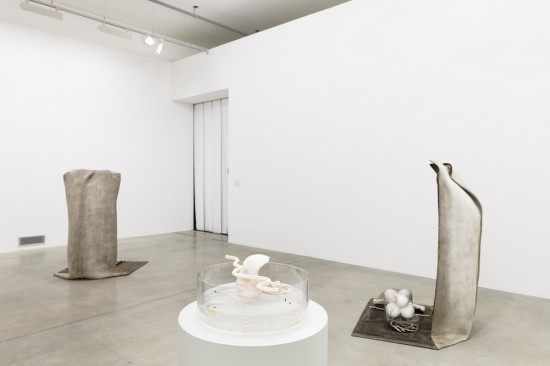 Alisa Baremboym – UNIT 2: Thyroid: Growth & Development, UNIT 3: Homunculus: Matter Against Memory, Chromosome Absorption (2018), installation view in “Crash Test” at La Panacée-MoCo, Montpellier, 2018. Photo: © Aurélien Mole, courtesy Alisa Baremboym.
Alisa Baremboym – UNIT 2: Thyroid: Growth & Development, UNIT 3: Homunculus: Matter Against Memory, Chromosome Absorption (2018), installation view in “Crash Test” at La Panacée-MoCo, Montpellier, 2018. Photo: © Aurélien Mole, courtesy Alisa Baremboym.ART iT: With your curation of the Taipei Biennial in 2014, “The Great Acceleration,” you took a turn to investigating the discourses on the Anthropocene, speculative realism and object-oriented ontology. You reference thinkers such as Quentin Meillassoux and Levi Bryant in your catalogue essay. Is this a prevailing theme for you now, or is it just one of your recent interests?
NB: I always explore several issues at the same time, and sometimes they merge into one another while at others they expand in different directions – not unlike a radicant line! But in fact my next book develops from the theme of the Taipei Biennial. It will include my essay for the Taipei catalogue, as well as several other texts that will be published for the first time.
ART iT: In today’s lecture [January 5] you were critical of Meillassoux and object-oriented ontology. If I understand correctly, you think that the idea of a world without subjectivity does not apply to art, because an artwork is always addressed to someone. Yet you still used these ideas as a reference for organizing an exhibition.
NB: Well, we should make a distinction between Meillassoux on one side and people like Graham Harman on the other. I think that Meillassoux is the most interesting of them all – the most complex. We can discuss our ideas together and he’s not that far from agreeing with me – especially about art, because it’s nonsense to think about art without humans. But Graham Harman tries to include art at the nonhuman level, which I think is totally pathetic and artificial. So Meillassoux articulates the idea of an object-oriented ontology far more subtly.
ART iT: At the same time, Althusser’s materialism of the encounter is also rooted in the nonhuman world. As you mention in books such as Relational Aesthetics and The Exform, Althusser sees the encounter of monads or atoms as the birth of the world.
NB: Right. I try to use Althusser’s theories of history to criticize speculative realism. The idea of history as a process without a subject actually contains the seeds of a criticism of speculative realism as a kind of totally other version of materialism – or “realism” as we now call it. I think the major task of the 21st century, in terms of philosophy, will be to reinvent materialism in a way that is not binary or dogmatic. Speculative realism is too binary in its systematic opposition of humans and nonhumans. We have to create subtler articulations. The next exhibition I am organizing at La Panacée-MoCo (Montpellier Contemporain) is titled “Crash Test: The Molecular Turn.” It will include 25 artists from different countries. All of the artists attempt to identify the real at the molecular level – not at the molar level of recognizable objects. They are trying to create what could be a social critique at the molecular level, from the material components of realism.
Nicolas Bourriaud: Between Practice and Theory
